Content marketing effectively achieves a range of marketing results for virtually every B2B and B2C company when done correctly.
In 2024 91% of B2B marketers used content marketing to reach customers, with 86% of B2C marketers viewing content marketing as a key strategy.
But are they doing it right? It turns out there is a way to tell. The significant difference between success and failure is whether you have a plan or not.
Table of Contents
Why Content Marketing Can Be a Zero
The data doesn’t lie. The Content Marketing Institute’s report, ‘Annual B2B Content Marketing Benchmarks, Budgets, and Trends: Insights for 2024’ shows the difference between having a plan and not:
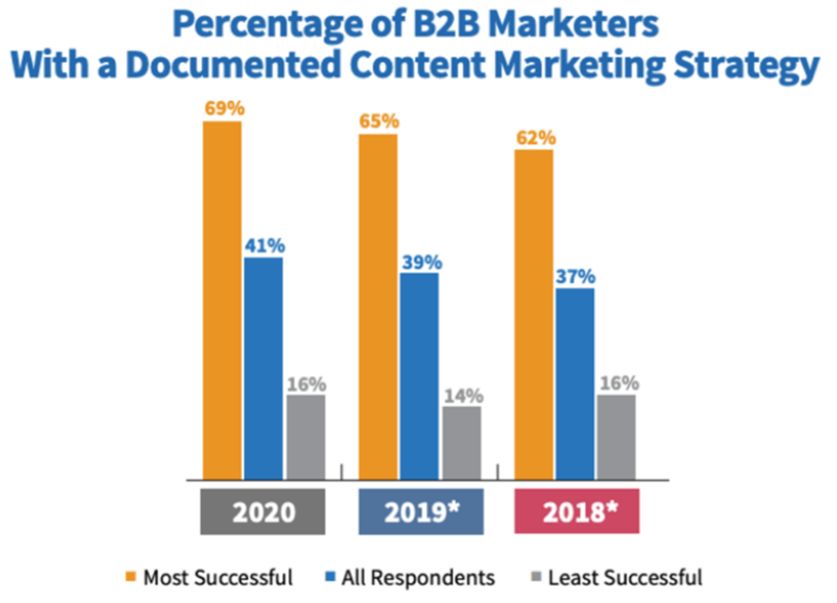
69% of content marketers who succeed have a plan. Of those who are least successful, only 16% have a plan. The numbers are pretty consistent over the past three years.
Note that B2C marketers document their strategy at a lower rate than B2Bs. For example, in 2024, it was 59%.
A not-uncommon approach to content marketing is to produce content around what your CEO or product manager wants to talk about or what product you wish to promote. It’s done ad hoc with the sole purpose of ‘having a blog.’
They end up producing short blog posts just to fulfill the quota without a purpose or strategy.
‘Write it, and they will come’ does not work and will lead to frustration and failure.
Producing content with a strategy and purpose is the only way to do content marketing right.
So how do you produce a plan, and what goes into it? The next steps will show you how to create a content marketing plan for success.
Step 1: Use Intent Keywords to Drive Topics
Your buyers’ keywords used to do research are what you should be using to create your content topics. Therefore, the best way to discover these topics is by doing keyword research.
We’ll spend some extra time here because this is the most crucial step in aligning with your buyers and increasing your chances to get ranked in Google.
This assumes you know your target buyers and/or personas to place yourself in your ideal customer’s buying journey.
If you have not done any targeting, it’s an essential first step in keyword research. Here is an excellent overview of targeting.
The Importance of Intent
Not just any keywords will do. First, you need to find keywords that buyers are using with an intent to buy.
Think about your target audience.
What terms would they use when thinking about pain points?
What solutions would solve them?
What keywords would they type into Google to get answers?
These are your high intent keywords. For example, If you sell a keyword research tool, a buyer may start their search by entering the keyword ‘best keyword research tool.’
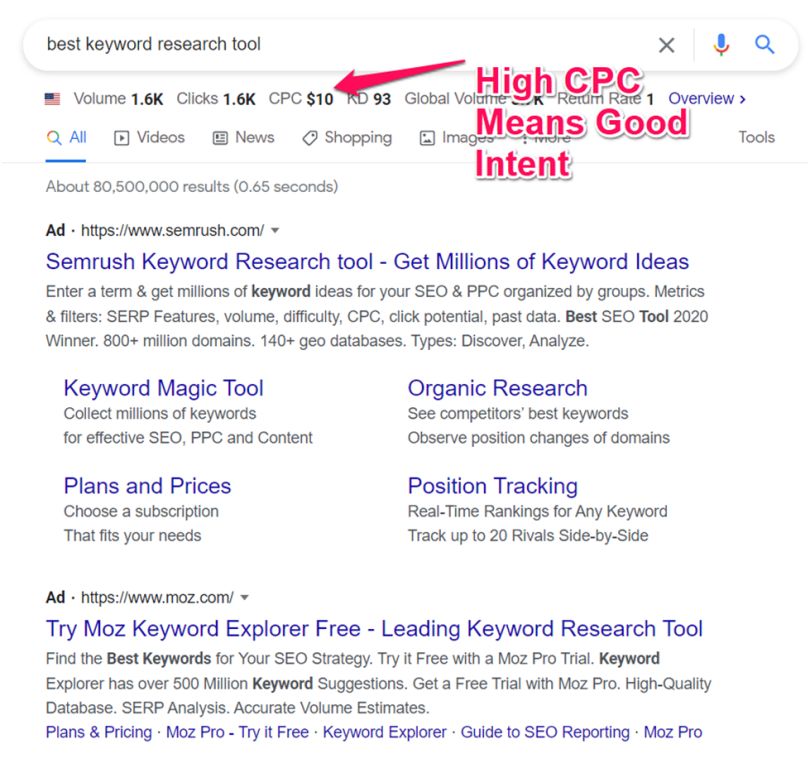
Besides the fact that this just looks like a good intent keyword, the high CPC (Cost Per Click) a paid advertiser will pay for the first position confirms it.
High CPC means advertisers know this keyword is converting well into leads or actual sales, so they will pay a high price to get that click.
For this result, Semrush will pay $10 every time someone clicks on their ad.
The top organic result is from the SEO training site, Backlinko.
By writing an authoritative post on ‘best keyword research tools, they are betting that buyers looking for keyword tools might also show intent for SEO training.
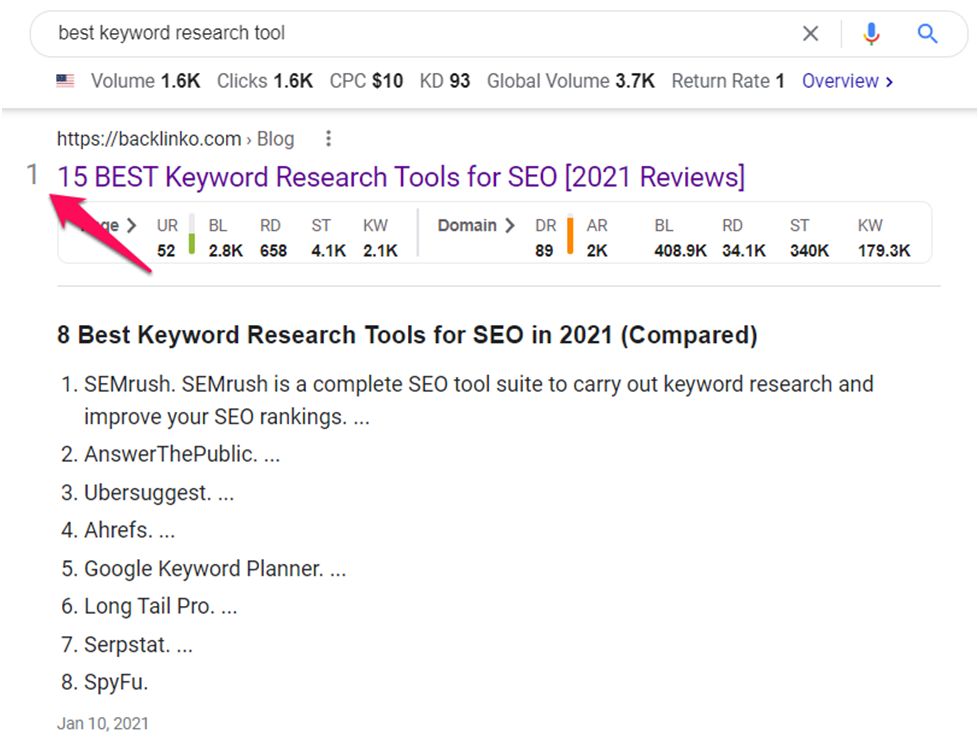
The goal is to define as many of these intent keywords as possible to form the basis for the topics you will use to produce content.
Keyword Research Method
Speaking of keyword research tools, you’ll need one to do the best research. There are several good ones, from free, like Soovle, to paid, like Moz, Semrush, and Ahrefs.
The paid ones give you a more in-depth analysis, such as CPC data.
We’ll use Ahrefs for the examples here.
For keyword research, you want to use two sources:
- Competitor keywords
- Industry terms
Competitor Keywords
This is the best first place to search. As you analyze multiple competitors, you will start to see a consensus emerge on good primary intent keywords, which forms the basis to discover long-tail keywords.
Go to your keyword research tool and enter the domain of your competitor.
For example, one of Ahref’s competitors is Semrush. By entering their domain in Ahrefs you get the following report on intent keywords where Semrush is ranking high:
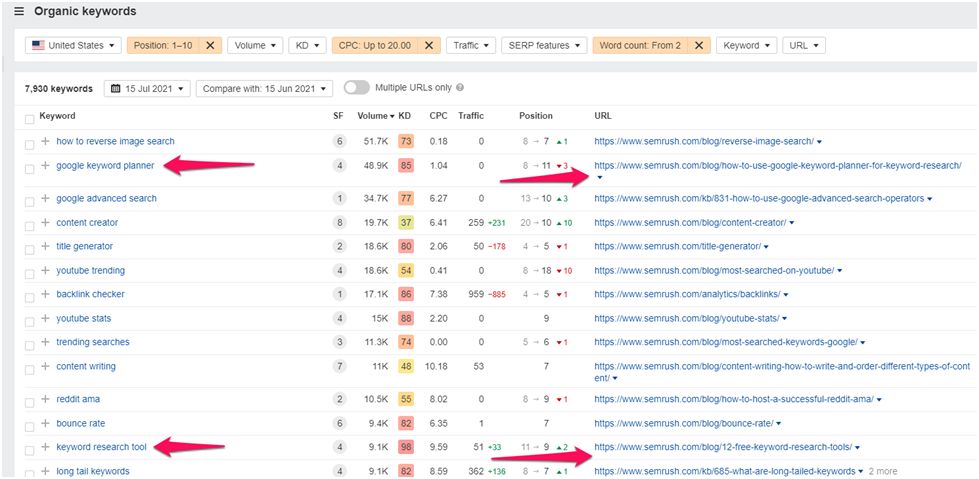
On the first page of results, some good intent keywords (and the pages that drive that keyword) are highlighted, including ‘keyword research tool.’
The search volume is 9,100. With a SERP (search engine results page) position at 11, estimated clicks are 51. Clicks are less than search volume because the further down you are in the results, the fewer clicks you’ll get compared to the top results (1-10).
You can see the CPC is $9.59. So based on that CPC, they are getting almost $500 in free traffic every month by ranking for that keyword.
You can do this same exercise for every competitor you have.
Create a spreadsheet and start noting which intent keywords are best for your offering. For example, note the keyword, volume, KD, CPC, and traffic.
Start With Keywords With Lower Keyword Difficulty (KD). From 1-100, it’s the measure of how difficult it is to get ranked in the top 10 for that keyword.
If you have strong competitors with high domain authority and hundred of keywords ranking in Google, you need to start looking for long-tail keywords with lower difficulty but good traffic as a good starting point to get ranked.
Here is an example:
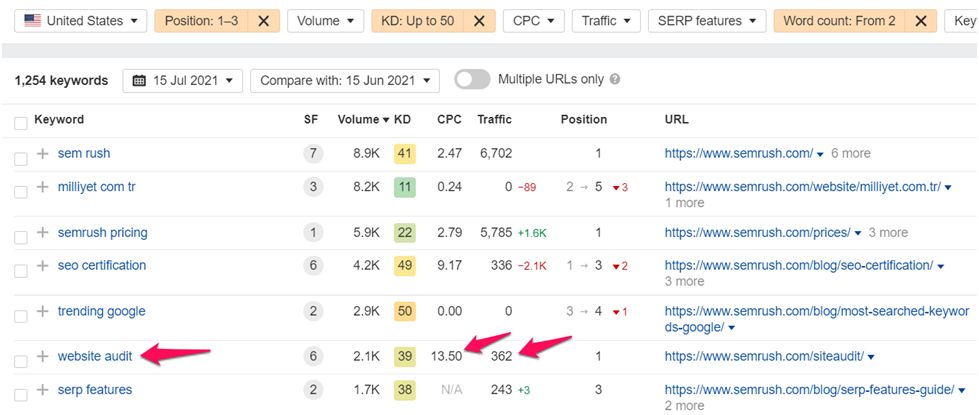
The term ‘website audit’ has a keyword difficulty of 39, which is low, a CPC of $13.50, which shows excellent intent, and forecast clicks at 362.
If you can rank well for this keyword, you can get $4,887 worth of free traffic (clicks x CPC). But better yet, a chance to convert that traffic into leads or sales.
Industry Keywords
These are keywords you know through experience and knowledge of your target buyer are common in your industry.
Start with these primary intent keywords, and then expand your list using your tool to find other, long-tail keywords with good click volume and low KD.
Here’s an example using ‘keyword research tool’ as the primary intent keyword:
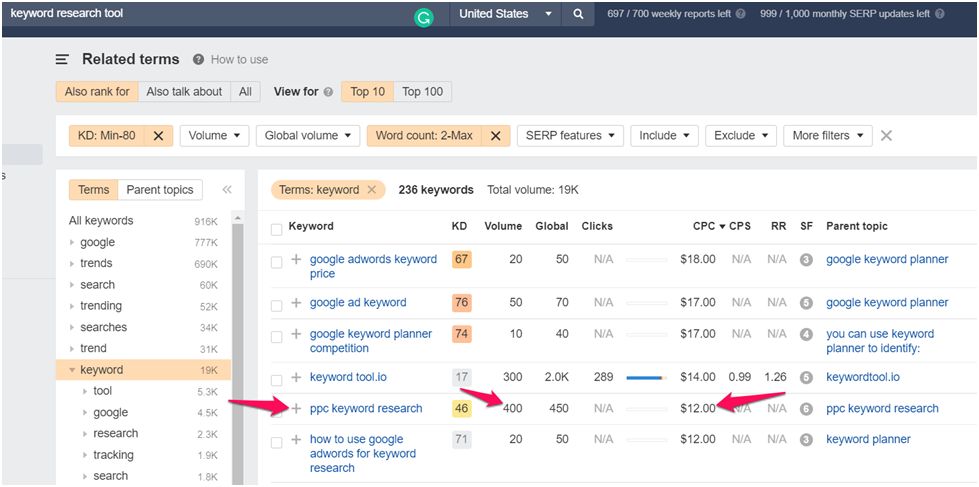
‘PPC keyword research’ has decent traffic at 400 searches, a great KD of 46, and a high CPC of $12. It would make an excellent topic for a blog post. You would have a good opportunity to get the number 1 ranking for this keyword.
Keep doing your research and adding keywords to your spreadsheet until you start to see the same ideal keywords repeating.
When you finish, the next step is to select your topics, create an editorial calendar (another key success factor) and organize your content so Google understands what questions you are answering.
Editorial Calendar
Look at your spreadsheet and start to identify keywords that would make good topics. Then, start entering those topics in an editorial calendar.
There are several options available for editorial calendar tools, but Excel or Google Sheets works well to start.
Enter the name of the topic, the format (blog, white paper, webinar, etc.), the author, the publish date, primary keywords, long-tail keywords, notes.
Start with your main intent keyword, for example, Best Keyword Research Tools, as your top, or pillar, post. Then use other long-tail keywords with lower KD and good traffic to create the cluster posts that support your main pillar post.
Step 2: Organize Your Content
Organize your content so Google better understands what you’re talking about. This increases your chances of getting ranked in the top 10.
The strategy is called the pillar-cluster model. Hubspot pioneered the model based on research they did in reorganizing their thousands of existing blog posts.
Before pillar-cluster, they wrote blog posts to rank for long-tail keywords and randomly published them all in their blog section, with internal links placed according to whatever each author wanted. It looked like this:
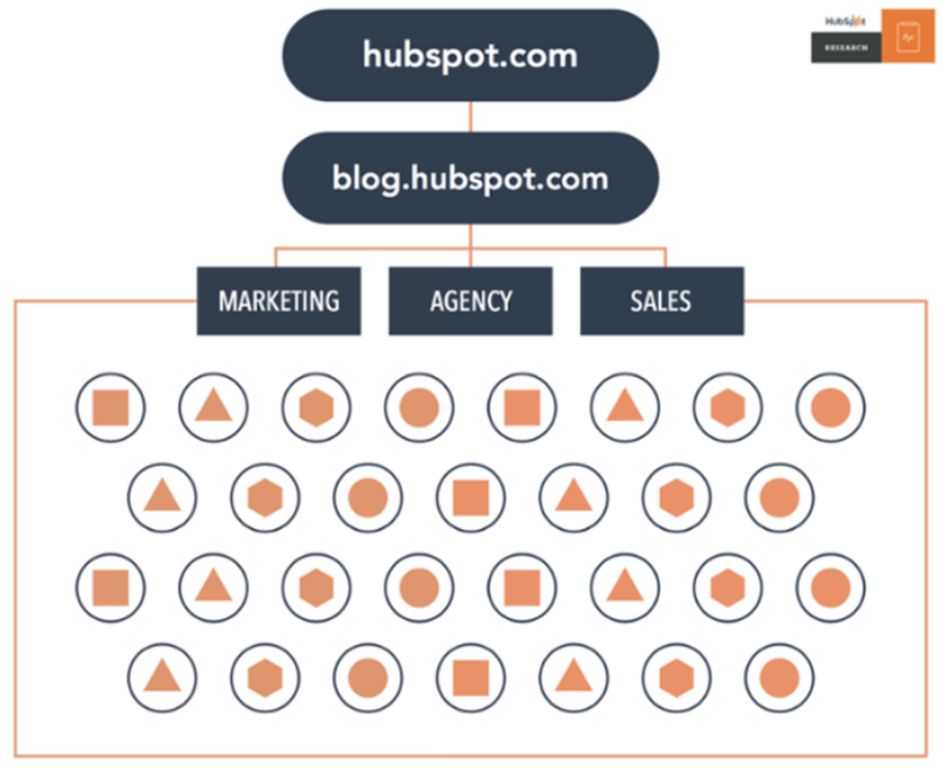
After they came up with the pillar-cluster model, their site looked like this:
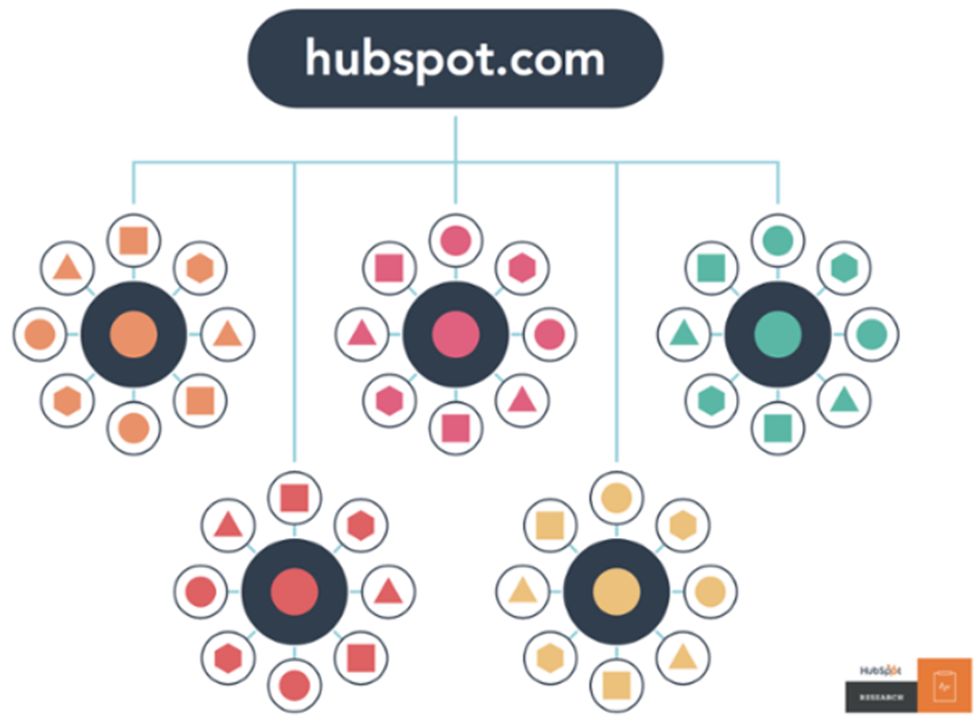
With each cluster looking like this:
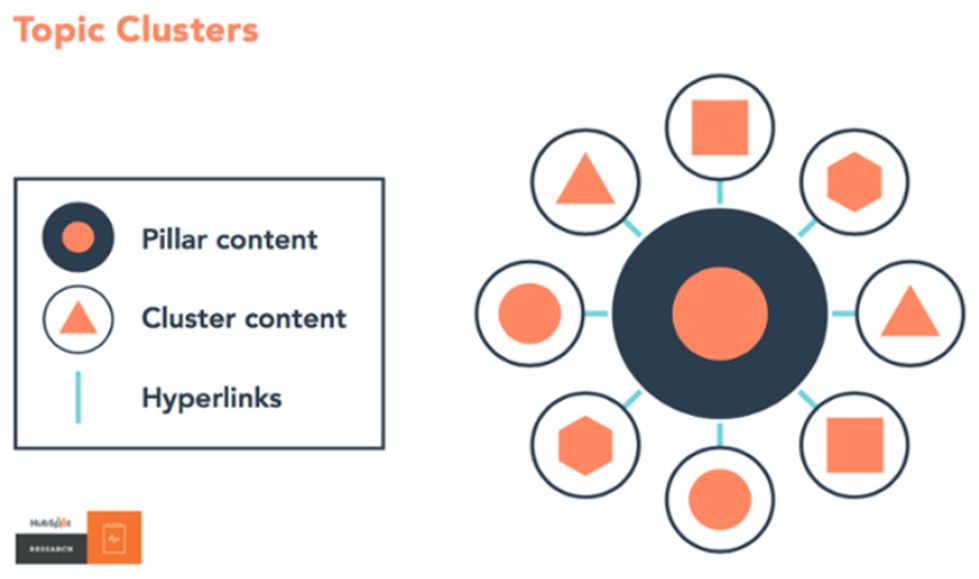
The pillar content in the middle of this graphic is one webpage that provides an authoritative overview of the topic, which then hyperlinks to more detailed cluster blog posts that make up a topic cluster. The cluster post has at least one link back to the pillar post.
For example:
Topic: Keyword Research Tools
Pillar Content Post: How to Select a Keyword Research Tool
Cluster Content Post: How to do PPC Keyword Research
The cluster topic will hyperlink back to the pillar page and out to other related cluster posts.
Since keywords tightly associate with the topic cluster, Google better understands what questions you are answering, giving all your content and long-tail keywords a better chance of ranking higher.
All the content you produce must meet the ACT (authoritative, comprehensive, trustworthy) standard if you hope to rank.
The days of writing 500-word blog posts are over. Google needs to see real engagement with content, or it won’t rank.
Step 3: Repurpose and Promote
Now you have an excellent resource pool of topics that resonate with your buyers.
Once you have your pillar topic, cluster topics, and an editorial calendar, plan to promote your content off-site. Here your efforts will start yielding immediate results.
It can take several months for your content to start organically ranking in Google as you build backlinks and domain authority and searchers start interacting with your content. So be patient; it is well worth it.
Many marketers become impatient because they don’t see ranking improvements in the first few weeks or months and think they’ve failed.
In the meantime, you can be proactive about placing your content, in part or whole, on web properties where your buyers visit to learn and do research.
It’s called repurposing or syndication. Repurposing is a great way to feed:
- Social media posts
- Lead magnets
- Email campaigns
- Industry publications
- PR
- PPC ads
- Webinars
- Sales materials
- Community forums
For example, you can break down your blog posts into snippets and images to repost them to your social media feeds.
Find websites where your buyers visit to talk about your topics. Then, reach out via email to ask if they will republish your blog post and provide a backlink to your site.
Sparktoro is an excellent resource for finding web properties where your buyers visit. Here is an example of their results for ‘keyword research.’ These are potential properties where you can reach out and ask about syndication opportunities.
SparkToro’s database has found 8,443 people that talk about keyword research.

Another way to find syndication opportunities is to search within URLs that contain your keywords using the Google parameter ‘inurl:’ and combine it with ‘republished with permission’ to see what sites in your industry accept third-party content.
It looks like this:
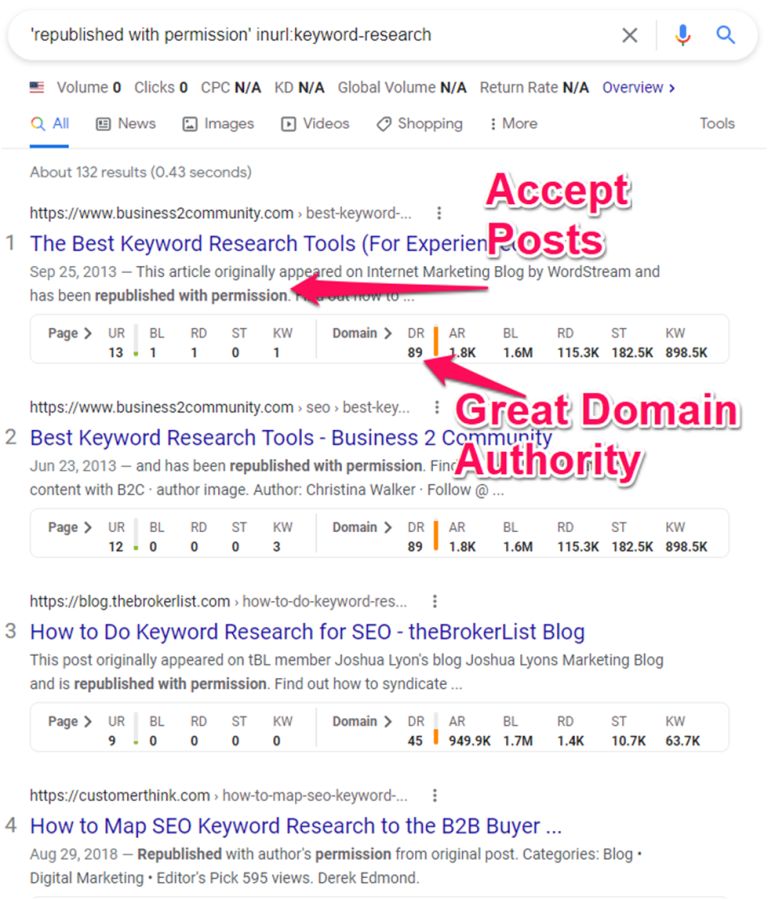
If you have some paid search budget, even if it’s only a few hundred dollars per month, apply your keyword research to promote your content on Google Ads (or Bing or Facebook). You get immediate placement on the top page of searches or in the feeds of your buyers.
Call to Action (CTA) Offers
Your CTA offers are another area where content marketing can fail. If you have great keywords grouped by intent, but your headlines, ads, and landing pages don’t meet buyer expectations, then conversions will suffer.
Harry Dry’s site Marketing Examples is an excellent resource to fine-tune your offers. He stresses the importance of framing the offer, not in terms of what you can do but what you can do for your buyers.
Here are some of his examples that will inspire you in the right direction:
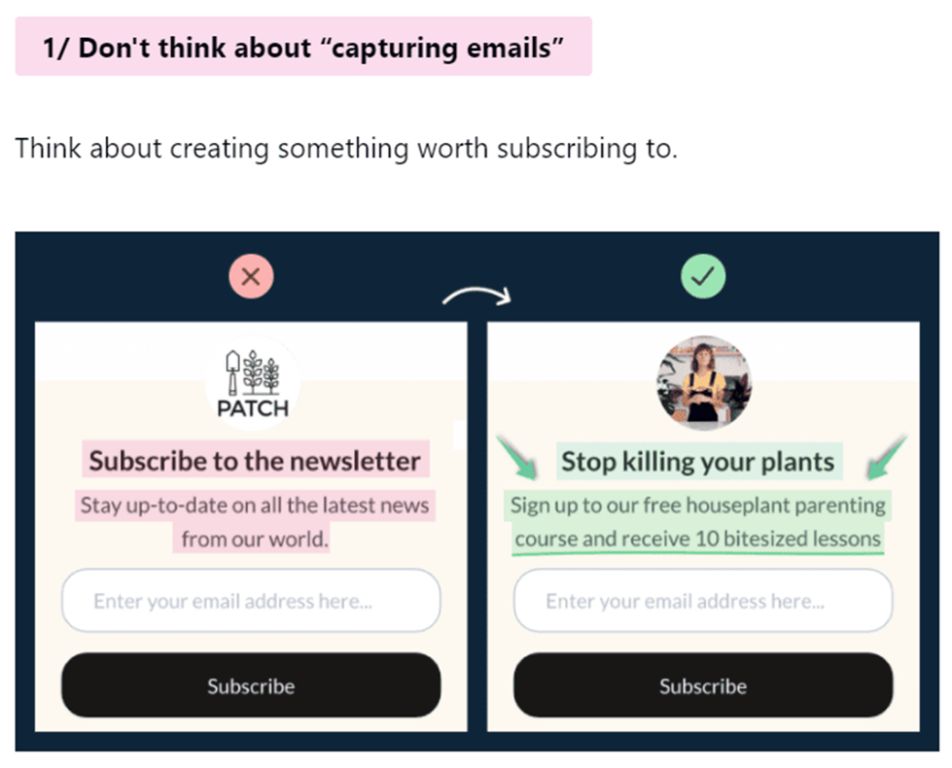

Students don’t care about the next generation of SAT prep. Instead, they care about acing the test.
Always be thinking about your customers, not you, when writing offers.
Step 4: Focus on Results and Measure
The point of having a plan is to work towards desired results. Without establishing clear objectives and key results (OKRs), you won’t know if your plan is succeeding or not.
If your key result is to generate 200 new conversions on your landing page starting in month three, you need to track conversions.
Other metrics like traffic and new vs. returning users are important, but only to understand what is driving conversions.
Look for good keywords and topics driving conversions and use those for insight into other marketing programs like website messaging and demand generation.
Here are some things you can measure in a content marketing program:
Overall Conversions – Are we meeting our bottom line metric?
Conversion by page – What topics are driving conversions
Conversions by source – What channels are working? Social? Paid?
Overall Traffic – Is it increasing or decreasing? Why?
Traffic by source – What channels are driving traffic? Put more resources into those.
Traffic by page – What topics are driving traffic?
Organic traffic – Something around 50% is ideal
Bounce rate – Good, authoritative content should engage. Bounce rates below 60% are good.
Dwell time – Should be in minutes for engaging content.
Conclusion
The top reason why content marketing fails is that there is no written plan and corresponding written results to measure success.
The most important part of the plan is to make sure you are creating content your buyers need. Research intent keywords and try to start with value, which means lower KD and good traffic.
Organize your content in the pillar-cluster model and have an editorial calendar to codify who is publishing what and when.
Be aggressive in getting your content published off your website via paid ads and content syndication.
Always make sure you are working toward a result, like conversions, putting an actual number to it.
Lastly, patience is critical. For content marketing to work ‘on all cylinders’ takes time. But, put in the effort now, and you’ll have a content marketing machine that will work for years.

Brian BloomKing has been using content marketing to help marketers generate conversions, leads and revenue for the past 12 years through is agency, The BloomKing Agency. The result has been over 19,000 marketing qualified leads generated for his clients who include Oracle, Adobe, and Salesforce.
Site: https://bloomking.com/
Twitter: https://twitter.com/bloomkingagency
LinkedIn: https://www.linkedin.com/company/the-bloomking-agency
Facebook: https://www.facebook.com/thebloomkingagency/
Instagram: https://www.instagram.com/the_bloomking_agency/ @the_bloomking_agency